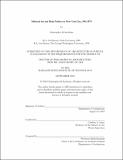| dc.contributor.advisor | Caroline A. Jones. | en_US |
| dc.contributor.author | Ketcham, Christopher M. (Christopher Michael) | en_US |
| dc.contributor.other | Massachusetts Institute of Technology. Department of Architecture. | en_US |
| dc.coverage.spatial | n-us-ny | en_US |
| dc.date.accessioned | 2019-03-11T19:04:04Z | |
| dc.date.available | 2019-03-11T19:04:04Z | |
| dc.date.copyright | 2018 | en_US |
| dc.date.issued | 2018 | en_US |
| dc.identifier.uri | http://hdl.handle.net/1721.1/120870 | |
| dc.description | Thesis: Ph. D. in Architecture: History and Theory of Art, Massachusetts Institute of Technology, Department of Architecture, 2018. | en_US |
| dc.description | This electronic version was submitted by the student author. The certified thesis is available in the Institute Archives and Special Collections. | en_US |
| dc.description | Cataloged student-submitted from PDF version of thesis. | en_US |
| dc.description | Includes bibliographical references (pages 335-362). | en_US |
| dc.description.abstract | In the mid-1960s, the artists who would come to occupy the center of minimal art's canon were engaged with the city as a site and source of work. These artists drew on the social, material, and spatial conditions of the surrounding environment, producing sculpture that addressed the problem of the city as a problem of the body. At the same time, minimal art was deployed by civic leaders, including New York City's mayor John V. Lindsay, as an instrument to organize a public and project a new urban image in the midst of sweeping social and economic change. The work of Carl Andre, Tony Smith, Dennis Oppenheim and many of their peers, informed by Merleau-Ponty's phenomenology, promised to heighten one's consciousness of self, others, and environment. The Lindsay administration and its allies positioned sculpture as an aesthetic rupture that could ameliorate the sensorial burden and alienation of urban life. The phenomenological and spatial claims of minimal art were adopted and mobilized by the city's power brokers as they sought to assert authority over New York. This dissertation assesses the intertwined agency of artists, political leaders, corporate stakeholders, and private developers as they made proprietary claims for urban space. In the canonical formation of minimal art, the city has been marginalized as a field of meaning. The phenomenological reading has become naturalized in historiography. Rather than perpetuate this historiographical opposition, this dissertation pursues an urban history of minimal art and a social history of its phenomenology. It focuses on artists and organizers whose work constitutes a sustained engagement with the social, material, and spatial realities of New York City in the 1960s. Merleau-Ponty's phenomenology resonated with artists in 1960s New York, in part, because it overlapped with a politics of the urban body that was developing simultaneously. The city's use of minimal art was closely related to the problematic visibility of politicized bodies. As Lindsay was confronted with issues of race, gender, and class that emerged in the wake of massive social and economic transition, his administration turned to minimal art to serve as a tangible sign of order. Sculpture was deployed as a tool to orient the body and the public within the city's new spatial realities. | en_US |
| dc.description.statementofresponsibility | by Christopher M. Ketcham. | en_US |
| dc.format.extent | 362 pages | en_US |
| dc.language.iso | eng | en_US |
| dc.publisher | Massachusetts Institute of Technology | en_US |
| dc.rights | MIT theses are protected by copyright. They may be viewed, downloaded, or printed from this source but further reproduction or distribution in any format is prohibited without written permission. | en_US |
| dc.rights.uri | http://dspace.mit.edu/handle/1721.1/7582 | en_US |
| dc.subject | Architecture. | en_US |
| dc.title | Minimal art and body politics in New York City, 1961-1975 | en_US |
| dc.type | Thesis | en_US |
| dc.description.degree | Ph. D. in Architecture: History and Theory of Art | en_US |
| dc.contributor.department | Massachusetts Institute of Technology. Department of Architecture | |
| dc.identifier.oclc | 1088723609 | en_US |
